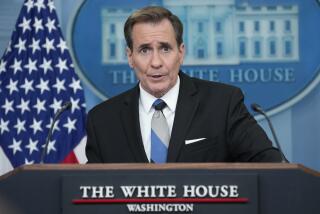‘Star Wars’ Program Gets New Focus : Defense: Bush tells Pentagon to shift its emphasis to providing protection from limited missile strikes rather than a large-scale attack.
- Share via
WASHINGTON — President Bush’s decision to “refocus” the “Star Wars” missile defense effort may give major new impetus to a program that had begun to lose its direction and political support since its heyday during the Ronald Reagan Administration.
Bush said Tuesday night he had directed the Pentagon’s Strategic Defense Initiative Office to shift its emphasis from providing a shield against a large-scale missile attack to providing “protection from limited ballistic missile strikes whatever their source.”
“This is a sort of ‘Star Wars light,’ ” said John Pike, an analyst with the Federation of American Scientists, a Washington-based research center that has been critical of the strategic defense initiative, popularly known as “Star Wars.”
“The Administration is basically trying to salvage as much of the program as they can now that the Soviet threat’s going away,” he added.
The White House decision comes as the Persian Gulf War has raised the specter of ballistic missiles, tipped with nuclear warheads or deadly chemical agents, in the hands of Third World dictators.
Although the Soviets’ arsenal of nuclear-tipped ballistic missiles is expected to decline with a new strategic arms accord, turmoil in that nation has prompted speculation about the possibility of a disgruntled Soviet commander unleashing a small but unauthorized nuclear strike on the United States or one of its allies.
Bush’s new direction was a response to those new realities, officials said.
For those within the Pentagon who lobbied for the new direction, Bush’s latest initiative is spelled GPALS, an acronym that stands for Global Protection Against Limited Strikes.
Unlike the Patriot, which is limited to defending against short-range missile attacks, GPALS would be designed to intercept long-range ballistic missiles, such as those now possessed by the Soviets. It could be deployed as early as 1997 at a cost of about $50 billion, according to independent analysts.
While the proposed GPALS is a greatly scaled-back version of the Reagan Administration’s plan for a “Star Wars” missile shield, it would maintain one of its critical features--multiple layers of defensive weapons that would engage incoming missiles in space and inside the atmosphere.
Such a system would spell the end of the 1972 Anti-Ballistic Missile Treaty which restricted the deployment of missile defenses by the United States and the Soviet Union.
As outlined by Pentagon officials in recent months, the GPALS system would consist of hundreds and perhaps thousands of ground-based interceptor missiles scattered in approximately a dozen sites inside the United States; about 1,000 space-based interceptors widely known as “brilliant pebbles,” and an array of space-based satellite sensors and ground-based radars to detect and track the incoming missiles. Early experimental versions of all three components have been tested repeatedly, many with outstanding successes.
The “brilliant pebbles” aspect of the GPALS missile defense system has been greatly reduced from the earlier “Star Wars” schemes, which envisioned a force of about 4,500 such space-based interceptors.
In addition, Bush’s initiative suggests the Pentagon will be given the go-ahead to proceed with major new research on a new generation of a Patriot-style missile system to intercept short-range missiles. The Patriot has intercepted dozens of short-range Scud missiles threatening Israel and Saudi Arabia in recent weeks. The Pentagon has spent millions in recent years to develop such weapons.
More to Read
Sign up for Essential California
The most important California stories and recommendations in your inbox every morning.
You may occasionally receive promotional content from the Los Angeles Times.














